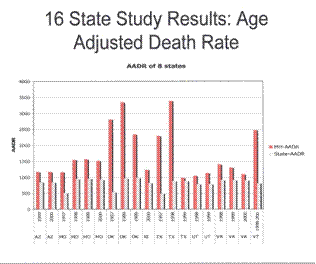|
|
|
In 2006, two pivotal papers summarized the results
of a federally funded study of mortality
|
|
(death rates) among
public mental health patients.
Sponsored by the Center for Mental
|
|
Health Services and
the National Association of State Mental Health Program Directors, the
|
|
investigation
solicited data from sixteen states.
Eight states returned information on the death
|
|
rates for patients
with Serious Mental Illness (SMI).
|
|
|
|
This slide
depicts annual age-adjusted death rates for SMI vs. the non-mentally ill.
|
|
|
|
Specifics of the
study:
|
|
|
|
1)data were collected for public mental health patients
receiving services between 1997 and 2000
|
|
|
|
2)SMI (serious mental illness) included major depression,
bipolar disorder, schizophrenia, and ADHD
|
|
|
|
3)in all 8 states which participated (AZ, MO, OK, RI, TX, UT,
VA, and VT), the seriously mentally ill
|
|
had higher rates of death than the
general population
|
|
|
|
4) when matched by
age to non-mentally ill individuals, patients with SMI died at an earlier age
--
|
|
on average, the SMI patients died 10 to
30 years earlier than expected
|
|
mean age at time of death: 49-60
|
|
|
|
5) most mental
health patients died of natural causes, such as heart disease and respiratory
conditions
|
|
|
|
Key limitations of the study:
|
|
>> investigators did not consider the
prevalence of dementia or dementia-related deaths
|
|
>> investigators did not consider the
role of medication in the deaths of those diagnosed with SMI
|
|
|
|
|
|
|
|
|

